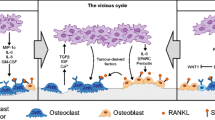Summary
After a 48-hour rehydration period 28 of 31 patients with cancer-associated hypercalcemia (serum calcium ≥2.8 mmol/1) were treated intravenously with the bisphosphonate pamidronate. In three patients fluid repletion with 0.9% saline solution had already normalized serum calcium levels. Pamidronate was given in a single infusion on day 0, the dose of pamidronate adapted to the severity of hypercalcemia. If the serum calcium concentration was ≥2.8 mmol/1 on day 3, application of pamidronate was repeated. In all patients normocalcemia was restored; mean serum calcium decreased from 3.2±0.35 on day 0 to 2.15±0.32 on day 12. Hypercalcemia recurred in 11 patients, seven of these underwent pamidronate treatment according to the same therapeutical regimen. Normal calcium levels were attained in five cases. Side effects were of minor gravity:brief hyperthermia occurred in four patients and transient, asymptomatic hypocalcemia was noticed in nine cases.
Similar content being viewed by others
Abbreviations
- PTHrP:
-
Parathormon ähnliches Peptid
Literatur
Blind E, Raue F, Zisterer A, Kohl B, Ziegler R (1990) Epidemiologie der Hypercalcämie. Dtsch Med Wschr 115:1739–1745
Body JJ, Borkowski A, Cleeren A, Bijvoet OLM (1986) Treatment of malignancy-associated hypercalcemia with intravenous aminohydroxypropylidene diphosphonate. J Clin Oncol 4:1177–1183
Bonjour JP, Philippe J, Guzelpa G, Bisetti A, Rizzoli R, Jung A, Rosini S, Kanis JA (1988) Bone and renal components in hypercalcemia of malignancy and responses to a single infusion of clodronate. Bone 9:123–130
Boonekamp PM, van der Wee-Pals LJA, van Wijk-van Lennep MML, Thesing CW, Bijvoet OLM (1986) Two modes of action of bisphosphonates on osteoclastic resorption of mineralized bone. Bone and Mineral 1:27–39
Broadus AE, Mangin M, Ikeda K, Insogna KL, Weir EC, Burtis WJ, Stewart AF (1988) Humoral hypercalcemia of cancer. Identification of a novel parathyroid hormone-like peptide. New Engl J Med 319:556–563
Fleisch H (1989) Bisphosphonates:a new class of drugs in diseases of bone and calcium metabolism. In:Brunner KW, Fleisch H, Senn HJ (Hrsg) Bisphosphonates and tumor osteolysis. Springer, Berlin Heidelberg New York, S 1–28
Gurney H, Kefford R, Stuart-Harris R (1989) Renal phosphate threshold and response to pamidronate in humoral hypercalcemia of malignancy. Lancet II:241–244
Harinck HIJ, Papapoulos SE, Blanksma HJ, Moolenar AJ, Vermeij P, Bijvoet OLM (1987) Paget's disease of bone:early and late responses to three different modes of treatment with aminohydroxypropylidene bisphosphonate (APD). BMJ 295:1301–1305
Harinck HIJ, Bijvoet OLM (1989) Clinical aspects of tumour-induced hypercalcemia of malignancy with APD. In:Burckhardt P (Hrsg) Disodium pamidronat (APD) in the treatment of malignancy related disorders. Huber, Bern Stuttgart Toronto, S 64–71
Harjung H, Fritze D (1990) Monotherapie mit Clodronat bei tumorinduzierter Hypercalcämie. Dtsch Med Wschr 115:48–52
Heath DA (1989) Hypercalcemia in malignancy. BMJ 298:1468–1469
Hosking DJ, Cowley A, Bucknall CA (1982) Rehydration in the treatment of severe hypercalcemia. Q J Med 200:473–481
Kanis JA, McCloskey EV, Paterson AHG (1990) Use of diphosphonates in hypercalcemia due to malignancy. Lancet I:170–171
Ladenson JH, Lewis JW, Boyd JC (1978) Failure of total calcium corrected for protein, albumin and pH to correctly assess free calcium status. J Clin Endocrin and Metab 46:986–993
Mangin M, Webb AC, Dreyer BE, Posillico JT, Ikeda K, Weir EC, Stewart AF, Bander NH, Milstone L, Barton DE, Francke U, Broadus AE (1988) Identification of a cDNA encoding a parathyroid hormone-like peptide from a human tumor associated with humoral hypercalcemia of malignancy. Proc Natl Acad Sci USA 85:597–601
Morton AR, Cantrill JA, Craig AE, Howell A, Davis M, Anderson DC (1988) Single dose versus daily intravenous aminohydroxypropylidene biphosphonate (APD) for the hypercalcemia of malignancy. BMJ 296:811–814
Moseley JM, Kubota M, Diefenbach-Jagger H, Wettenhall RE, Kemp BE, Suva LJ, Rodda CP, Ebeling PR, Hudson PJ, Zajac JD, Martin TJ (1987) Parathyroid hormone-related protein purified from a human lung cancer cell line. Proc Natl Acad Sci USA 84:5048–5052
Ralston SH, Gardner MD, Dryhmburgh FJ, Jenkins AS, Cowan RA, Boyle IT (1985) Comparison of aminohydroxypropylidene diphosphonat, mithramycin, and corticosteroids/calcitonin in treatment of cancer associated hypercalcemia. Lancet II:907–910
Ralston SH, Alzard AA, Gallacher SJ, Gardner MD, Cowan RA, Boyle IT (1988) Clinical experience with aminohydroxypropylidene bisphosphonate (APD) in the management of cancerassociated hypercalcaemia. Q J Med 258:825–834
Ralston SH, Gallacher SJ, Patel U, Dryburgh FJ, Fraser WD, Cowan RA, Boyle IT (1989) Comparison of three intravenous bisphosphonates in cancer-associated hypercalcemia. Lancet II:1180–1182
Ritch PS (1990) Treatment of cancer related hypercalcemia. Semin Oncol 17 [Suppl 4]:26–33
Scharla SH, Minne HW, Sattar P, Mende U, Blind E, Schmidt-Gayk H, Wüster C, Ho T, Ziegler R (1987) Therapie der Tumorhypercalciämie mit Clodronat. Dtsch Med Wschr 112:1121–1125
Scharla SH, Grauer A, Ziegler R (1991) Therapie des Morbus Paget mit dem Bisphosphonat (AHPrBP, früher APD) Klin Wochenschr 69:25–30
Thiebaud D, Jaeger P, Jacquet AF (1986) A single day treatment of tumor induced hypercalcemia by intravenous aminohydroxypropylidene bisphosphonate. J Bone Min Res 1:555–562
Thiebaud D, Jaeger P, Jacquet AF, Burckhardt P (1988) Dose-response in the treatment of hypercalcemia of malignancy by a single infusion of the bisphosphonate AHPrBP. J Clin Oncol 6:762–768
Thiebaud D, Jaeger P, Burckhardt P (1990) Response to retreatment of malignant hypercalcemia with the bisphosphonate AHPrBP (APD):respective role of kidney and bone. J Bone Miner Res 5:221–226
Thomas M, Schneider W (1989) Differentialdiagnose und Therapie der tumorbedingten Hypercalcämien. Dtsch Med Wschr 114:1576–1581
Yakatan GJ, Wesley JP, Talbert RL, Floyd BF, Slough CL, Ampulski RS, Benedict JJ (1982) Clodronate kinetics and bioavailibility. Clin Pharmacol Ther 31:752–760
Author information
Authors and Affiliations
Rights and permissions
About this article
Cite this article
Pecherstorfer, M., Janisch, S., Marosi, C. et al. Pamidronat in der Behandlung der tumorassoziierten Hypercalcämie. Klin Wochenschr 69, 690–695 (1991). https://doi.org/10.1007/BF01649438
Received:
Revised:
Accepted:
Issue Date:
DOI: https://doi.org/10.1007/BF01649438




